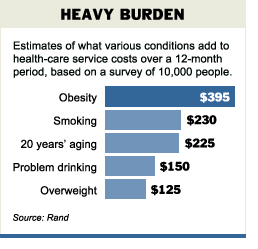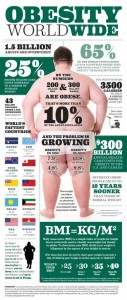Morbid obesity is a serious medical condition that is defined as having a body weight of over one hundred pounds than the recommended weight and having a body mass index (BMI) of over 40.
What causes obesity?
Obesity is primarily caused when the calorie intake is consistently greater than its expenditure through physical activity. The excess unused energy is stored in the body as fat. Morbid obesity is not caused primarily because of overeating. Nor is it caused by laziness and gluttony. It is a complex medical disorder that depends on many other factors.
Contributing Factors for Morbid Obesity
Genetic predisposition for morbid obesity is more when other members of the family have the same medical condition. Psychological and environmental factors play a major role in determining eating habits. Responding to emotions such as sadness and anger by overeating, and the method and style of cooking, whether they exercise as part of their everyday life, all play a role.
Inability to feel full after taking in a certain amount of food is true for certain individuals because of flaws in the physical and chemical makeup of their bodies. Physical problems such as endocrine disorders, certain medications, and psychiatric illnesses are also known to cause morbid obesity.
The disease called morbid obesity affects most basic physical functions such as breathing, walking, etc. The presence of this medical condition can give rise to other adverse health conditions including cancer.
How to Escape from Obesity
Physical exercise and controlled calorie intake are the main ways in which obesity can be controlled. Increasing fiber intake while simultaneously reducing the consumption of energy-dense foodstuffs, refined sugars and starches improves the quality of the diet and consequently helps to stabilize and reduce weight over a period of time. An active life and regular daily exercise also help to control the gain of weight.

For those who suffer from obesity, anti-obesity drugs that serve to reduce appetite may be prescribed. If drugs, exercise and diets do not work, surgery to reduce the volume of the stomach or length of the bowels may be an option for morbid obesity.
However, in my opinion, the best way to properly beat morbid obesity is through consistent exercise and proper nutrition. This way, you not only lose the weight, but an individual will also learn better decisions to keep it off and set a great example to their kids so they won’t go down the same road to being obese.
There are many exercise programs for people that are obese. Programs to get the body and joints moving slowly at first and increase intensity through time as the body develops. Programs like 10 Minute trainer, Tai Cheng, and Slim in 6 are great and proven programs to do in home.
Cost of Obesity

The current obesity costs in the United States are about $147 billion in a year. Obese individuals spend approximately 42% more than others on their health care. About $62 billion out of the $147 billion is for Medicare and Medicaid. Taxpayers and employers pay up to 2.9% of their earnings towards Medicare. The medical costs that were paid up by third-party payors for obese individuals were $1,429 higher than others of normal weight.
Obesity related absenteeism costs about $4.3 billion on an annual basis. With increased BMI of an individual, costs due to sick leave days and medical claims increase.
Statistics reveal that about a third of the adults in the United States are obese. About 17% of children and adolescents are obese. On top of that, 3 out of every 5 adults today are overweight and 2 out of every 5 children are as well. There must be an example taught to these people that need help. That is, living a more active lifestyle and eating healthy daily.

Neglecting one’s body or overindulging in fatty and unhealthy foods does not just hurt the individual. It raises the medical costs for all taxpayers, reduces workplace productivity, and impacts the entire nation economically. The simple fact is that everybody is in the picture together.
Obesity Statistics
There are an estimated 5 to 11 million people in the United States who suffer from morbid obesity. This means every one person among 20 people is morbidly obese. Morbid obesity is the second highest leading cause of preventable death in the United States. The number of deaths in a year due to this problem is about 400,000. The number of people who have a BMI of over 50 increased by an astounding 75% between the years 2000 and 2005.
Consequences of Obesity and Morbid Obesity
Obesity is known to lead to stigmatization in society and disadvantages in employment. Some studies indicate that obese individuals are less likely to be hired for jobs. They are less likely to be promoted as well. Obese individuals are more prone to falls and injuries. They incur more costs for their employers whether it’s from health care costs or loss productivity, or the inability to perform their job as expected.
The morbidly obese belong to the high-risk health group. They have more chances to have the habit of snoring, according to the people at https://snorebay.com/are-snoring-devices-safe/. They are more at risk to suffer from disorders such as diabetes, heart disease, sleep apnea, joint disease, infertility, reduced life expectancy, low self esteem, back problems, acid reflux, etc., among many others.
Recent Studies on Morbid Obesity
Recent studies have indicated that in a significant number of individuals with morbid obesity, a section of their DNA is missing which contain about 30 genes.
Scientists have studied how leptin resistance sets in, develops, and aids in the progress of obesity. This will prove helpful in providing clues for the treatment of morbid obesity.

[box type=”note” style=”rounded” border=”full” icon=”none”]I love Comments and Feedback…Please share your stories, fitness goals, and questions with us below in the comment section.[/box]
Live Passionately,

[related_posts limit=”5″]
